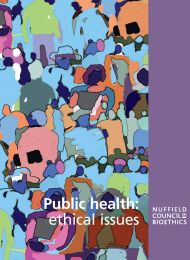Public health: ethical issues
Report
Published 13/11/2007

Our report starts from the position that the state has a duty to enable people to lead healthy lives. Everyone should have a fair opportunity to lead a healthy life, and therefore governments should try to remove inequalities that affect disadvantaged groups or individuals. We propose a ‘stewardship model’ that outlines the ethical principles that should be considered by public health policy makers.
The stewardship model
Acceptable public health goals include:
- reducing the risks of ill health that result from other people’s actions, such as drink-driving and smoking in public places
- reducing causes of ill health relating to environmental conditions, for instance provision of clean drinking water and setting housing standards
- protecting and promoting the health of children and other vulnerable people
- helping people to overcome addictions that are harmful to health or helping them to avoid unhealthy behaviours
- ensuring that it is easy for people to lead a healthy life, for example by providing convenient and safe opportunities for exercise
- ensuring that people have appropriate access to medical services
- reducing unfair health inequalities
At the same time, public health programmes should:
- not attempt to coerce adults to lead healthy lives
- minimise the use of measures that are implemented without consulting people (either individually or using democratic procedures)
- minimise measures that are very intrusive or conflict with important aspects of personal life, such as privacy
Consent
Individual consent is not always relevant or appropriate when considering public health measures. For example, individual consent might be unnecessary if the measure is not very intrusive or if it prevents significant harm to others. Furthermore, in some situations it may be more appropriate to obtain approval from the population as a whole (through democratic decision-making procedures), in particular where there is only a limited degree of interference with individuals’ liberty and no substantial health risks.
Applying the stewardship model
The components of the stewardship model are not listed in an order of priority, and the different elements could come into conflict, for example the elements of protecting children and minimising intrusion into private life. There is no set rule for resolving these conflicts. However, the overall aim should be to achieve the desired health outcomes while minimising restrictions on people’s freedom.

Share